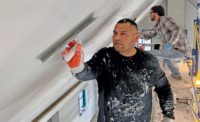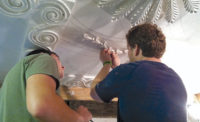In some languages, and localized areas of the English-speaking world, plaster is mineral specific, such as a gypsum-derived material, or “use specific,” such as a coating applied on interiors. However, our English word plaster ultimately derives from the Greek emplastron (εµπλαστρον) meaning to daub on.
So the term plaster can rightly describe a variety of interior or exterior coatings that are daubed, thrown or trowel applied.
Sgrafitto
This technique of carving into a plaster to reveal a contrasting color underneath is very much associated with the Italian tradition, from whom we have directly borrowed the word sgrafitto meaning scratched. However, the Italians in turn had borrowed the term from the Greek gráphein (γράφειν) meaning to write.
From the same origins, the Germans first coined the common designation for the form of carbon useful for scratching, that is to say writing: graphite.
Gypsum Plaster
The Greek word gypsos (γύψος) described the mineral that we today identify as gypsum.
Gypsum plasters may contain sand and small percentages of other binders such clay or lime.
Many useful gypsum plasters are in fact a blend of different types of gypsum:
- Gyp – Pulverized gypsum with the chemical designation hydrated calcium sulphate (CaSO4•2H2O). Often used as a natural accelerator in gypsum plaster.
- Beta Gypsum – Gypsum baked at a low temperature to form calcium sulphate hemi-hydrate (CaSO4•~0.5H2O). Also, known as Plaster of Paris.
- Alpha Gypsum – The hemi-hydrate form baked under higher barometric pressure. The resulting material can have up to 10 times the compressive strength of beta gypsum.
- Anhydrous Gypsum – Gypsum baked at a higher temperature to form pure calcium sulphate (CaSO4). Often used as a natural retarder in gypsum plaster.
Gypserie
The technique of chiseling into fresh plaster in deep relief in situ called gebs in Arabic is a craft that was developed to perfection by the Moors. After the expulsion of the Moors from the Iberian Peninsula, Muslim artisans were given opportunity to convert and some continued their craft in Christian motifs developing a very rich tradition in Provence.
Gypsum is the ideal medium for this technique. While fresh gypsum plaster is soft enough to easily carve it has great plasticity and will not easily crumble. This makes it possible to achieve deep undercuts with sharp edges and thin details that soon develops hardness and durability as the plaster dries and fully cures.
Screed
Finally we have an English word that has its roots in English.
“Screed” is an Old English word that originally meant a strip of cloth but eventually came to mean a strip of anything. In fact, shred has the very same etymology.
In plastering it refers to strips serving as a termination and guide for the larger infill areas. Often if wood, metal or non-plaster materials are used it will be referred to as a ground. However, if the strip is made of plaster it maintains the name screed.
Also, a screed is a generic term for the straight edge used to level the infill surface and the act of leveling is called screeding. There are a variety of screeds that have specialty applications with names such as rods, darbies, slickers, etc.
Render, Float, Set
This grouping of vocabulary comes from across the pond, common terminology in the United Kingdom and Ireland.
It is most descriptive (but not exclusively) of the traditional three coat lime plastering system used over monolithic substrates such as brick or stone.
The render is the first coat of plaster, the coarse stuff with large, sharp aggregates. It applies rough and gets scratched up to provide a mechanical key or bonding surface for the next coat.
The float is the next coat with the same material. However, the surface is scoured, compressed and leveled with a wooden hand float, hence the name.
The set is the final coat. This is the final mix with lime putty and fine aggregates with Plaster of Paris (gypsum plaster) added to initiate a set or firming up of the lime.
Scratch, Brown, Finish
This description of a three coat plaster system (usually over lath) is more common in the United States and applies to all types of plasters: lime, gypsum, cement, etc.
The scratch coat is the base layer and as you might guess receives scratches to receive the next coat. It is important that the scratches run horizontal; essentially forming little shelves for the next coat to sit inside and lock into.
The brown coat is the middle coat. Traditionally, either brown sand was used or some mineral tint was added so that the plasterer could easily gauge if he had sufficiently covered the scratch and to make sure he had good coverage when applying the finish.
The finish is applied last. Unlike the first two coats where thickness was achieved and the geometry of the wall was established, the finish is typically a thin veneer to create a smooth surface.













